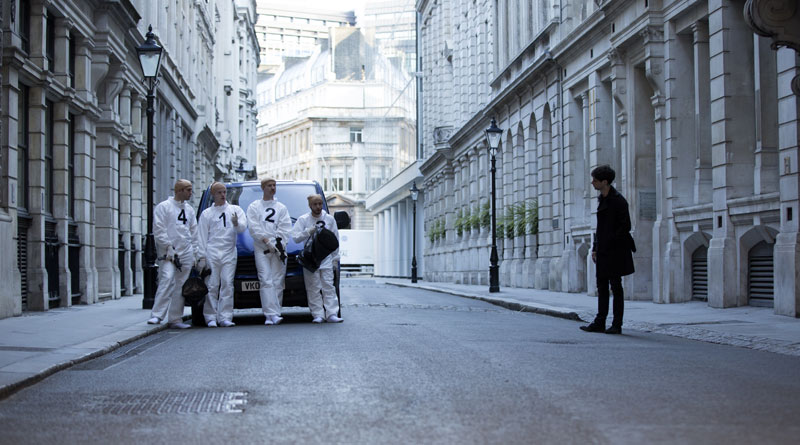Let’s get the obvious jokes out of the way: releasing a film called Remainder the day after the EU referendum was either a cruel coincidence or a flashy marketing move that’s backfired horribly. On the other hand, perhaps the story of a man struggling to recover from a traumatic head injury is perfect viewing for these fractured and anxious times.
Directed by Omer Fast, the Israeli-born Berlin-based artist whose superb solo exhibition at BALTIC has just closed, Remainder is an adaptation of Tom McCarthy’s 2005 novel. Yet, the question of fidelity that commonly stalks cinematic versions of literary works is particularly spurious in this instance. For Remainder is all about the problems of authenticity, of obsessively searching for the original. This is a fictional world in which every gesture is second-hand, every movement is a re-enactment, every image involves editing and re-playing the past.

Remainder (film still; 2016), Omer Fast.
Rather than comparing McCarthy’s novel with Fast’s film, it’s more productive to see both as part of a fluid network, a constellation of cultural reference points. In terms of cinema history, the artistic fantasies of Fellini’s 8½ (1963), the stylized performances of Scorsese’s Mean Streets (1973), the looping time-warp of Marker’s La Jetée (1962), and the mediated memories of Lynch’s Lost Highway (1997) – all these resonate and repeat in Remainder.

Remainder (film still; 2016), Omer Fast.
Contemporary art is an even stronger presence. Fast’s bruised protagonist, played with the ideal level of affectless cruelty by Tom Sturridge, is a kind of artist. Aided by an impeccably resourceful producer, he’s compelled to spend the £8.5 million in compensation that he receives for an unexplained accident on a series of re-enactments and performances. The results are as detailed and driven as those choreographed by Jeremy Deller and Marina Abramović – a set of installations as uncanny as a Rachel Whiteread house or a Pablo Bronstein stage set, a succession of conceptual gestures worthy of Sophie Calle or Bruce Nauman. All this takes place within the very spaces – corporate office blocks, post-industrial warehouses and gentrified flats in Berlin and London – that epitomise the architecture of today’s art world. There’s even a sense, in the blank de Chirico-esque masks worn by participants in one of Remainder’s relentlessly rehearsed set pieces, that what underpins the artistic endeavor in the film is the Freudian dream-analysis and Surrealist innovation that shaped 20th-century art.

Remainder (film still; 2016), Omer Fast.
With Remainder, Fast joins the growing number of visual artists who have turned to cinema in recent years. Most prominent among these is Steve McQueen, whose 12 Years a Slave (2013) earned him an Oscar to go with his Turner Prize, while Douglas Gordon and Philippe Parreno, with Zidane (2006), and Iain Forsyth and Jane Pollard, with 20,000 Days on Earth (2014), have offered fresh takes on the biopic. (The less said about Sam Taylor-Johnson’s recent cinematic output the better.) Perhaps the most pressing issue for an artist making a feature film is the different narrative strategies attendant to the respective viewing conditions. While a gallery spectator can enter, leave and move around at will, cinema audiences are fixed in place for the film’s duration. In his gallery-based works, Fast exhibits films without an obvious start or end point; composed of looping episodes, they may leave a spectator unsure of the work’s temporal boundaries. With the mesmerizing Remainder, he gives us a cinematic protagonist who adopts a similar editing process in his own life, compulsively seeking that perfect authentic moment.

Remainder (film still; 2016), Omer Fast.
A fantasist obsessed with re-playing the past? Maybe the release of Remainder was perfectly timed to coincide with Brexit Britain after all.
Remainder opened in UK cinemas on 24 June.
Unlimited access from just $16 every 3 months
Subscribe to get unlimited and exclusive access to the top art stories, interviews and exhibition reviews.














![Masterpiece [Re]discovery 2022. Photo: Ben Fisher Photography, courtesy of Masterpiece London](http://www.apollo-magazine.com/wp-content/uploads/2022/07/MPL2022_4263.jpg)
Why are fathers so absent from art history?